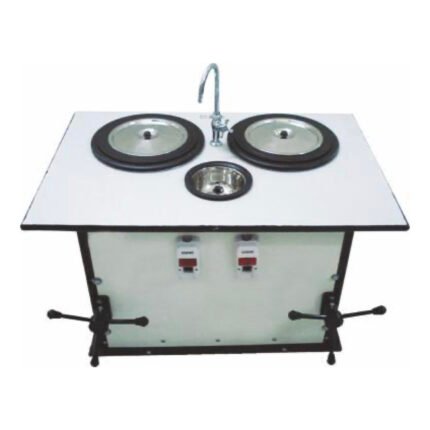AZA 1016 METALLURGICAL INVERTED MICROSCOPE
- AZA 1016 Metallurgical Inverted Microscope: For precise inspection of opaque materials.
- Inverted design ideal for large, heavy, or irregular samples.
- High-quality infinity-corrected LWD metallurgical objectives (20x-1000x).
- Powerful Epi-Illumination (Halogen/LED) with Koehler setup.
- Robust mechanical stage and precise coaxial focusing.
- Trinocular head for camera attachment, enabling image capture.
- Essential for metallography, quality control, and R&D in materials science.
- Manufactured with durable die-cast aluminum stand
Description
AZA 1016 Metallurgical Inverted Microscope: Precision for Opaque Material Analysis by Azalab
The Azalab AZA 1016 Metallurgical Inverted Microscope is an advanced optical instrument specifically engineered for the high-precision examination of opaque materials, such as metals, alloys, ceramics, and composites. Unlike conventional upright microscopes, its unique inverted design allows for the effortless inspection of large, heavy, or irregularly shaped specimens directly placed on the stage, without the need for extensive sectioning or mounting. This makes the AZA 1016 an indispensable tool for metallography, materials science, quality control, failure analysis, and research across various industries in India, including automotive, aerospace, manufacturing, and academic institutions.
The Advantage of the Inverted Design with the AZA 1016 Metallurgical Inverted Microscope
The primary distinguishing feature of the AZA 1016 is its inverted optical path. The objective lenses are located beneath the stage, pointing upwards, while the illumination source is positioned above the stage, pointing downwards. The specimen, typically a polished and sometimes etched surface, is placed face-down on the mechanical stage. This configuration offers significant benefits for metallurgical and materialographic applications:
- Sample Accessibility: Large, bulky, or heavy samples can be placed directly on the stage without requiring special fixtures or cutting them down to a small size. This is particularly advantageous for industrial components or raw material samples.
- Stable Viewing Plane: The polished surface of the specimen rests flat on the stage, ensuring a consistent focal plane across the entire surface, regardless of the sample’s overall geometry. This eliminates the need for precise leveling, common with upright microscopes when viewing mounted samples.
- Reflected Illumination: Since light cannot pass through opaque samples, the AZA 1016 Metallurgical Inverted Microscope utilizes reflected (epi) illumination. Light is directed onto the sample from above, reflects off the surface, and passes back through the objective lenses to the eyepiece or camera. This allows for detailed examination of microstructures, grain boundaries, inclusions, and surface defects.
- Safety and Convenience: Reduced risk of objective collision with large samples compared to upright configurations. The open space above the stage also facilitates the use of external manipulation tools if needed.
Key Features for High-Performance Microscopic Examination: The AZA 1016 Metallurgical Inverted Microscope is built with precision components to deliver clear, high-contrast images and reliable performance:
- Superior Optics: Equipped with long working distance (LWD) infinity-corrected metallurgical objectives (e.g., M4x, M10x, M20x, M40x, M50x, M100x), ensuring excellent resolution, flatness of field, and image clarity across the entire magnification range (typically 20x to 1000x). These objectives are often anti-fungal and anti-reflected coated.
- Versatile Illumination: Features a powerful built-in Epi-Illumination system (e.g., 12V-50W Halogen lamp or high-intensity LED) with adjustable brightness, field diaphragm, and aperture diaphragm for Koehler illumination. This allows for versatile observation modes such as brightfield and often includes provisions for darkfield, polarized light, and optionally DIC (Differential Interference Contrast) depending on the configuration.
- Ergonomic Observation Head: A 45-degree inclined Binocular or Trinocular head with wide field eyepieces (e.g., WF10x/FOV 20mm or 22mm) provides comfortable viewing. Interpupillary distance and diopter adjustments ensure personalized viewing comfort. The trinocular port allows for easy attachment of a digital camera for image capture and analysis.
- Robust Mechanical Stage: A large, sturdy mechanical stage (e.g., 172mm x 142mm with X-Y movement range of 30mm x 30mm or more) with coaxial low-drive controls mounted on ball-bearing guide ways ensures smooth, precise movement and accurate positioning of the specimen.
- Precise Focusing System: Coaxial coarse and fine focusing knobs with a ball-bearing guide system provide smooth and accurate focusing, allowing for precise control over the specimen’s Z-axis position.
- Nosepiece: A precision quadruple or quintuple revolving nosepiece ensures accurate optical alignment and easy objective changes.
- Integrated Filters: Typically includes green and blue filters for enhanced contrast and specific observation requirements. A polarizer and analyzer may also be integrated for polarized light observations.
Applications and Compliance in the Indian Context: The AZA 1016 Metallurgical Inverted Microscope is an essential instrument for:
- Microstructural Analysis: Examining grain size and shape, phase distribution, twin boundaries, and internal defects in metals and alloys.
- Inclusion Rating: Assessing the type, size, and distribution of non-metallic inclusions in steel and other materials (e.g., as per ASTM E45).
- Coating Thickness Measurement: Evaluating the thickness of metallic or non-metallic coatings.
- Case Depth Measurement: Determining the depth of hardened layers in heat-treated components.
- Failure Analysis: Investigating fracture origins, corrosion mechanisms, and other material failures.
- Quality Assurance: Ensuring that materials and components meet specified microstructural standards in manufacturing units. While the microscope itself doesn’t typically carry direct ASTM or ISO certification, its design and capabilities are tailored to enable precise metallurgical examination in accordance with recognized industry standards such as:
- ASTM E3: Standard Guide for Preparation of Metallographic Specimens.
- ASTM E407: Standard Practice for Microetching Metals and Alloys.
- ASTM E112: Standard Test Methods for Determining Average Grain Size.
- ISO 4967: Steel – Determination of Content of Non-metallic Inclusions.
Azalab’s Commitment to Quality and Support: Azalab is committed to delivering high-quality, precise laboratory and industrial equipment that supports critical material analysis and quality control. The AZA 1016 Metallurgical Inverted Microscope reflects our dedication to innovation, accuracy, and user satisfaction. We understand the importance of reliable microstructural insights for ensuring the integrity, performance, and longevity of materials and products. Our instruments are engineered to meet the highest demands of modern material testing laboratories in India and globally, backed by comprehensive customer support.
Further Information and Resources: For detailed operational procedures, specific applications, and integration with image analysis software, users should refer to the product manual, relevant industry standards, and consult with Azalab’s technical support.
Specifications:
- Model: AZA 1016
- Microscope Type: Inverted Metallurgical Microscope
- Observation Head: Binocular or Trinocular (45° inclined), with interpupillary and diopter adjustment.
- Eyepieces: Wide Field (WF) 10x (Paired), FOV 20mm or 22mm, anti-fungal, anti-reflected.
- Objectives: Long Working Distance (LWD) Infinity Corrected Plan Achromatic Metallurgical Objectives.
- Typical Magnifications: M4x, M10x, M20x, M40x (SL), M50x, M100x (SL, Dry).
- Anti-fungal & infinity corrected.
- Total Magnification: 20x to 1000x (with 10x eyepieces).
- Nosepiece: Quadruple or Quintuple revolving nosepiece on ball bearings.
- Mechanical Stage: Co-Axial low drive double plate mechanism system, travel on ball bearing guide ways.
- Stage Size: Approx. 172mm x 142mm.
- Moving Range: Approx. 30mm (X) x 30mm (Y) or more.
- Focusing System: Co-axial coarse and fine focusing mechanism system with ball bearing guide ways.
- Fine Focus Division: 0.002 mm (2 µm).
- Illumination: Built-in Epi-Illumination system (e.g., 12V-50W Halogen lamp or high-intensity LED) with light intensity control, field diaphragm, and aperture diaphragm.
- Filters: Green & Blue filters included. Provisions for Polarizer/Analyzer.
- Stand: Sturdy and durable pressure Die-cast Aluminium stand.
- Power Supply: 220-240V AC, 50/60 Hz, Single Phase.
- Dimensions (Approx.): [W x D x H – e.g., 350 x 450 x 400 mm].
- Weight (Approx.): [e.g., 10-15 kg].
- Country of Origin: Made in India.
- Optional Accessories: Digital camera, image analysis software, specific objectives (e.g., Darkfield, DIC), various filters.
FREQUENTLY ASKED QUESTIONS (FAQ):
- Q: What is the main advantage of an inverted metallurgical microscope like the AZA 1016?
- A: Its inverted design allows for easy placement and stable viewing of large, heavy, or irregularly shaped opaque samples, eliminating the need for precise leveling.
- Q: What types of materials can be examined with the AZA 1016?
- A: It is designed for opaque materials such as metals, alloys, ceramics, composites, and other solid industrial samples.
- Q: What magnification range does the AZA 1016 offer?
- A: The standard magnification range is typically from 20x up to 1000x, depending on the combination of eyepieces and objectives.
- Q: Can I attach a camera to the AZA 1016 for image capture?
- A: Yes, the AZA 1016 typically features a trinocular head, allowing for easy attachment of a digital camera for image acquisition and analysis.
- Q: What are some common applications of this microscope in industry?
- A: It’s widely used for microstructural analysis, grain size determination, inclusion rating, coating thickness measurement, case depth measurement, and failure analysis in various manufacturing and R&D sectors.
- Q: Does it use transmitted or reflected light?
- A: It uses reflected (epi) illumination, as opaque samples do not allow light to pass through them.
Additional information
| Model |
AZA 1016 |
|---|---|
| Microscope Type |
Inverted Metallurgical Microscope |
| Total Magnification |
20x to 1000x (with 10x eyepieces). |
| Nosepiece |
Quadruple or Quintuple revolving nosepiece on ball bearings. |
| Power Supply |
220-240V AC, 50/60 Hz, Single Phase. |
| Dimensions (Approx.) |
[W x D x H – e.g., 350 x 450 x 400 mm]. |
| Weight (Approx.) |
[e.g., 10-15 kg]. |
Related products
AZA 1009 HYDRAULIC COMPUTERIZED UTM
- AZA 1009 Hydraulic UTM: High-capacity Universal Testing Machine.
- Servo-hydraulic system for precise force and displacement control.
- Computerized control with comprehensive software.
- Tests tensile, compression, bending, and shear strength.
- Complies with ASTM and ISO standards.
- Essential for testing large metallic specimens, concrete, and structural components.
- Robust and reliable for demanding industrial applications.
- Available in various force capacities
AZA 1011 ROCKWELL HARDNESS TESTER
AZA 1012 BRINELL HARDNESS TESTER
- AZA 1012 Brinell Hardness Tester: For accurate Brinell hardness measurement.
- Robust design for reliable testing.
- Wide force range and standard indenters.
- Available with optical or digital indentation measurement.
- Complies with IS 1500, ASTM E10, and ISO 6506-1.
- Essential for quality control of metallic materials.
- Suitable for testing non-homogeneous materials and large components.
AZA 1013 CHARPY IMPACT TESTER
- AZA 1013 Charpy Impact Tester: Measures material toughness and resistance to brittle fracture.
- Pendulum-type tester with robust construction for stability.
- Available with high-resolution analog or digital energy display.
- Complies with key Indian (IS 1757) and International (ASTM E23, ISO 148-1) standards.
- Essential for quality control of metals, alloys, and critical components.
- Features precise hammer, anvils, and safety braking system.
- Helps assess ductile-to-brittle transition temperature.
AZA 1014 FATIGUE TESTING MACHINE
- AZA 1014 Fatigue Testing Machine: Evaluates material resistance to cyclic loading.
- Predicts component service life and prevents fatigue failures.
- Features precise cyclic load application and high-frequency operation.
- Advanced digital control and comprehensive data analysis software.
- Complies with international standards like ASTM E466 and ISO 1143.
- Essential for R&D, quality control, and failure analysis in various industries.
- Robust construction ensures reliable and repeatable fatigue test results.
- Available with various load capacities and test modes (axial, bending, torsion).
AZA 1015 TENSILE TESTING MACHINE
- AZA 1015 Tensile Testing Machine: Advanced UTM for material characterization.
- Precisely measures tensile strength, yield strength, and elongation.
- Features high-precision load cell and digital control.
- Variable crosshead speeds for diverse material testing.
- Complies with major standards: IS 1608, ASTM E8, ISO 6892, etc.
- Includes user-friendly software for data analysis and reporting.
- Essential for quality control, R&D, and failure analysis across industries.
- Robust construction ensures reliable and repeatable results.
AZA 1017 DOUBLE DISC POLISHING MACHINE
- AZA 1017 Double Disc Polishing Machine: For superior metallurgical specimen finishing.
- Features two independent polishing discs for efficiency.
- Individual variable speed control for optimal results.
- Robust, corrosion-resistant construction with integrated water cooling.
- Achieves mirror-like, scratch-free surfaces for microstructural analysis.
- Essential for quality control, R&D, and failure analysis in materials industries.
- Enhances efficiency and reproducibility in sample preparation.
AZA 1018 SPECIMEN MOUNTING PRESS
- AZA 1018 Specimen Mounting Press: Essential for metallographic sample preparation.
- Robust manual hydraulic press for hot mounting.
- Features integrated electrical heating (up to 200°C) and water cooling.
- Digital temperature control for precise curing.
- Compatible with various interchangeable mold sizes (e.g., 25mm, 30mm, 40mm).
- Ensures consistent, void-free, and perfectly shaped mounts.
- Crucial for quality control, failure analysis, and research in materials science.

 Rock
Rock Aggregate
Aggregate Cement
Cement Concrete
Concrete Soil
Soil Steel
Steel Bitumen/Asphalt
Bitumen/Asphalt Security Survey Equipment
Security Survey Equipment General Items
General Items









